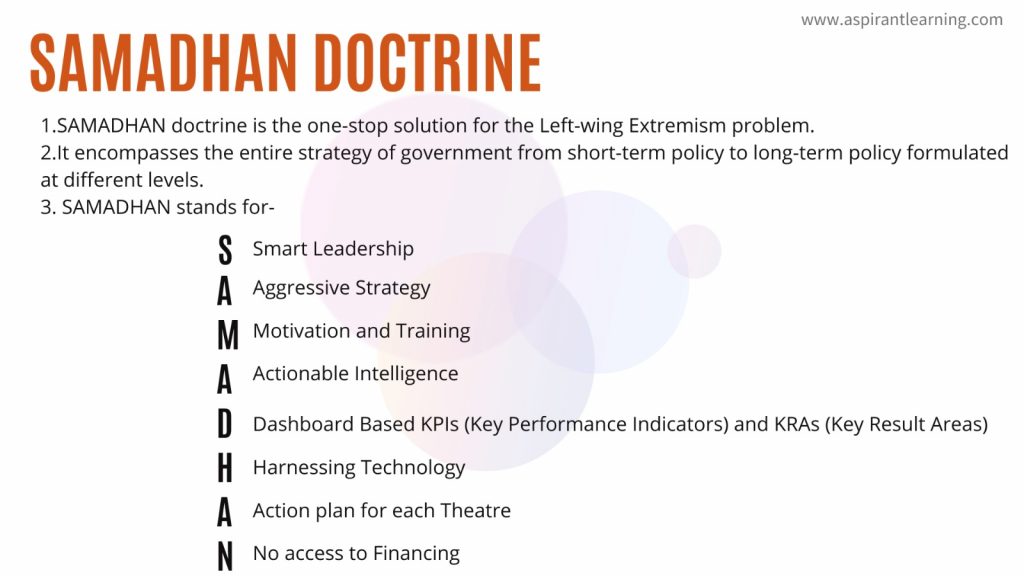News Highlights:
- Left Wing Extremism(LWE): Union Home and Cooperation Minister Shri Amit Shah chaired the meeting of the Parliamentary Consultative Committee of the Ministry of Home Affairs on Left Wing Extremism in New Delhi.
- The Union Home Minister said there is no place for violence and Left Wing Extremism ideas in the “self-reliant New India”.
Key Findings:
- Reduction in Causality:
- For the first time after nearly 4 decades, in 2022, civilian and security forces’ deaths have been brought to under 100.
- 76% reduction in violent incidents related to Left Wing Extremism is observed in 2022 compared to 2010.
- The number of civilian and security personnel who lost their lives in Left Wing Extremism incidents came down by 90% to 98 in 2022 compared to the figure of 1005 in 2010, and the number of Left Wing Extremism-affected districts reduced to 45 from earlier 90.
- Armed Forces Strengthening:
- Security forces have successfully established 175 new camps in Left Wing Extremism-affected areas since 2019.
- In the past year, the BSF Airwing has been strengthened with the addition of new pilots and engineers to support operations in areas impacted by Left Wing Extremism and save the lives of our soldiers.
- Additionally, funds were given to the State police forces for modernisation and help with building fortified police stations.
- Infrastructure development:
- Several special schemes are being implemented to develop Left Wing Extremism-affected areas.
- To increase road connectivity, 17,462 km of new roadway development has been approved, of which 11,811 km have already been built.
- In addition, 2,343 mobile towers have been installed in the first phase of the Mobile Tower Project.
- Establishment of Eklavya schools:
- Since August 2019, the opening of Eklavya schools in Left Wing Extremism affected tribally dominated blocks has been prioritised.
- 245 Eklavya Schools have been sanctioned in 90 Left Wing Extremism-affected districts, and out of these, 121 are functional.
Left-Wing Extremism:
- About:
- Left-wing extremism, also known by other names such as Naxalism and Maoism, is a form of armed insurgency against the State motivated by leftist ideologies.
- Left-wing extremists are also known as Maoists globally and as Naxalites in India.
- History of LWE in India:
- The word “Naxalism” comes from the name of the West Bengali village of Naxalbari, where in 1967, a peasant uprising against local landowners over a land dispute took place.
- The Telangana peasant insurrection (1946–1951) was when Left-Wing Extremism (LWE) in India first emerged. The movement peaked in 1967 when peasants, landless labourers, and Adivasis seized a landlord’s granaries in the West Bengali village of Naxalbari.
- Charu Majumdar, along with his close friends Kanu Sanyal and Jangal Santhal, served as the leader of the Naxal uprising.
- People from adjacent villages and the People’s Republic of China helped these rebels addition to locals. This movement was dubbed “Spring Thunder” by the Chinese media.
- Mao Zedong, China’s founding father, served as the movement’s initial source of inspiration, but it has since diverged significantly from Maoism.

Causes of left-wing extremism in India:
- Unfair development:
- The failure of land reforms, particularly after independence about land redistribution.
- Unemployment, socioeconomic disparities, and future gloom.
- Dominating groupings that are dishonest and self-serving.
- Lack of political opportunity results in helplessness or a sense of helplessness.
- Lack of title to public land used for farming by people without land.
- Remote Red Corridor regions have a governance gap. The influence zone of LWE in India is called the Red corridor.
- Corruption in the Public Distribution System causes a lack of food security (which is often non-functional).
- Conventional occupations are being disrupted, and a lack of alternatives to those occupations.
- Discrimination against tribals:
- Laws preventing the transfer of tribal land to non-tribals in the Fifth Schedule territories are not being appropriately implemented.
- Traditional land rights are only sometimes recognised under the FRA of 2006.
- Government rejecting tribal land grants.
Way Forward:
- The government needs innovative solutions for locating armed groups in the thick forests of the Naxalism-affected regions.
- Local Police know the language and topography of a region, and they can fight Naxalism better than the armed forces.
- The government needs to ensure two things: the peace-loving people’s security and the development of the Naxalism-affected regions.
Pic Courtesy: Freepik
Content Source: PIB



